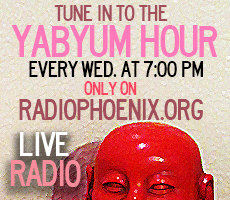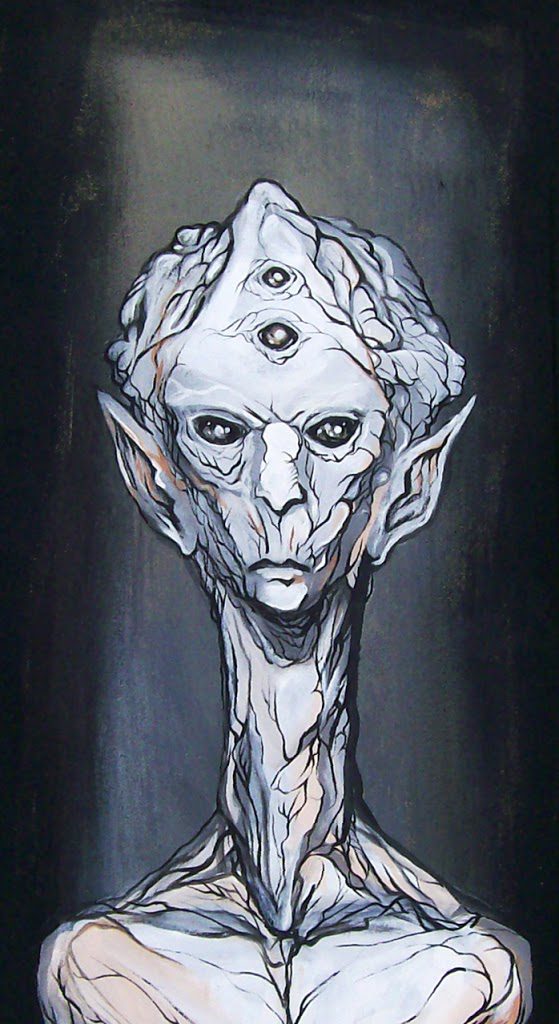
All photos by Jacob Sullivan
by Bob Hanshaw
Contributing Writer
Gabe Sullivan, all in black, met me at the Tap Room at Congress and ordered a mezcal (his girlfriend had instructed him not to order any beer, because he was getting a cold). Though he’s lived here all his life, he’s only really come into his own over the last five years or so, like many of the people interviewed for the Tucson Portraits series so far. But he’s packed a lot into that brief space. Sullivan is a fixture in Tucson music.
“The first song that I ever learned to sing was ‘Waitin’ Around To Die’ by Townes Van Zandt.” Ever since, his music has taken a turn for the dark, for the unsung.
Sullivan’s music covers a huge swath of genres. Punk and hardcore experience in adolescence led to a gig playing bass with The American Black Lung. Coming back from 4 years of hard touring with that group, he started Fell City Shouts with Brittany Katter and some of the Black Lung guys, telling them “Just play quieter!” He met Andrew Collberg (a pop singer-songwriter) through that project, who then hooked Sullivan up with Nick Luca (jazz and everything else) and Craig Schumacher (the head of Wavelab Studios). And after playing the first post-All Souls Procession “Flor de Muertos” concert, he was more or less inducted into the Latin scene here – with Brian Lopez, Sergio Mendoza, The Jons, “all the Nogales guys.” He disovered cumbia and co-founded Chicha Dust with Lopez. Chris Black (Chamberlab) introduced him to “Romanian gypsy music and Balkan brass,” which led to the formation of his flagship ensemble, Taraf de Tucson. And now he’s finally working on a solo album with a softer, singer-songwriter approach, pulling in Latin and rock and atmospheric influence, backed by the Danish musicians who comprise the instrumental core of Giant Sand these days – which Sullivan has also played in.
You could say the guy gets around. And he’s only 26.
 250 SONGS IN 250 DAYS
250 SONGS IN 250 DAYS
For all that, Sullivan is not immune to feelings of inadequacy and frustration. That’s what drove him to pursue the project that has taken up most of 2014 for him: writing a new song every day. Every single day. “It’s been pretty fucking crazy,” he says, shaking his head. Sulllivan has posted about 250 songs so far, and has barely missed a day.
“You feel jealous of people close to you, you see other friends succeeding, and you think… Why am I not getting those opportunities? In my mind, I was… waiting for a record label to offer me a 3-record deal, waiting for somebody to offer me money to record [in the studio]. And I wasn’t playing music, it was all this business and all this stuff that didn’t really exist. And it was starting to become sickening.” Indeed, a recent song Sullivan posted on his series, “Why Can’t I,” asks that very question: “Why can’t I / have what they have?” and was announced to Facebook with an emotional post about the validity of being an artist at all, when “there are problems far greater.”
But Sullivan decided “I like playing music because I like playing music,” period. And with one mic and a laptop, he set out to prove it, at least for a while. He was “playing it because it’s fun, writing it because it’s fun, recording it however I could. Some of those recordings are just on an iPhone.”
 THE RED ROOM
THE RED ROOM
Sullivan may be a prolific – and gifted – songwriter, but he considers himself to be still making his way into the songwriter scene in Tucson. It’s very different than the punk and hardcore scene, “where you’d get together with the same 4 dudes and practice the same songs every night.” Sullivan’s entree into songwriting, per se, overlapped his stint in American Black Lung, and truly began when he started booking acts at the Red Room.
The Red Room, as out-of-town readers may recall from earlier articles, was the hub of a vibrant Tucson music scene for several years. It’s now a burnt-out husk on Congress, destroyed with its sister restaurant Grill on New Years’ Day, 2013. But in 2009 or so, Gabriel Sullivan was hired as the booker. “When Chris Black decided he didn’t want to do it anymore,” he says. “He knew that I knew all the musicians in town, and I always need little side jobs. And I was there every night anyway.” Sullivan’s style of running the place was sort of brutally no-nonsense, in keeping with Grill’s antagonistic menu (and sometimes staff). The website explained that they don’t book bands who claim a street team and a strong buzz: “We already have a strong buzz, which comes from beer.” It kept things real.
More to the point, the circle of musicians who tended to play the Red Room had a completely different way of operating than heavier bands. “This circle was – someone would sing a song and you’ve never heard it, and [they would say] ‘Yeah, just play along.’ It was all about improv, all about making stuff up on the spot. That was all new to me, but I loved it. I was like ‘Oh, this is playing music! This is being a musician!’” Sullivan played almost every night for two years, mostly at Red Room. He would play piano, drums, guitar, whatever anyone needed at the time. “I made so many friends there.”
“It would have been so great to have this meeting there,” Sullivan reflects, speaking of our interview. Hotel Congress is something of a locus for Tucson music now – as it was then – but Red Room holds many musicians’ hearts even still. We reminisce about the destruction, the fiery death of the place. “But it’s so perfect. It would have been so sad to see another business open in there.”
Sullivan laughs. “I just wonder who burned it down.”
 A DIAMOND IN THE ROUGH
A DIAMOND IN THE ROUGH
While he was booking at the Red Room, Sullivan’s father mentioned that he should check out Billy Sedlmayr. “’He just got out of prison, playing some concerts in Phoenix. Great songwriter.’ I looked him up and there’s this big Phoenix New Times article about Billy… I read it and it was like, what the fuck, this is crazy! And this dude’s still alive?”
Billy Sedlmayr was, and remains, alive. At the time, he had no online presence, and Sullivan had no idea how to get a hold of him. He admired the music he was able to find, including a collaboration with Rich Hopkins (Sand Rubies, Luminarios). Eventually, word got around – probably through Al Perry, yet another Tucson fixture – that Sullivan wanted to book Sedlmayr, and they connected. The last 18 months or so at Red Room featured month-long songwriter residencies, and Sedlmayr inaugurated the series. The two have worked together ever since.
Sedlmayr is not the easiest character. He’s physically frail, a legacy of decades of drug use and hard experience. His story is “about as dark as it gets… I was still dealing with that when I first met him, he was still using, still coming out of that cave.”
But Sullivan saw something in him that resonated deeply. Sedlmayr is “a dude who nobody would give a chance to… a lot of his old friends are really happy for him now, seeing what he’s doing, but there’s still a lot of people who will not trust him, a lot of people who already wrote him off and that’s that.”
“[There are] so many people and so many situations that kind of go unsung,” Sullivan says, and Sedlmayr embodies that in a way. “Writing about more tragic and seedy kind of stuff. Real life stuff, like addictions and living on the streets and the general sadness that’s in life, that maybe a lot of people find ways to hide, or to put on blinders, to not have to pay attention.”
“But it’s important to realize that it’s there. And that if you’re thinking about that stuff you probably have it a lot better than a lot of people, and the least you can do is recognize that.” Sedlmayr’s work is beautiful and stark, encapsulating little pieces of the grand and awful story of his life, never quite descending into self-pity. Sullivan was determined to bring that work to light, to give it the recognition he truly believes it deserves.
So he managed the whole project, shepherding an album’s worth of material from Billy’s notebooks to tape. He organized a Kickstarter campaign, which was successful, though it got tense right before the end. And then Sullivan and Sedlmayr got together for a month and a half and worked the songs out. “He’s such a great writer, a lot of his songs originally had like 10 verses. They were 7-minute songs, all of them. I was like, ‘These are great, Billy, but we got to bring it down a little bit.’ …Those afternoons in the living room were the hardest part.”
The album is done now, pressed and all, waiting for release at the end of September. The musicians Sullivan recruited for this project are now his go-to crew for the other projects he produces. “It’s been a long journey, but I love the guy.”
 TO JUPITER BY WAY OF AARHUS
TO JUPITER BY WAY OF AARHUS
I tell Sullivan how his name is mentioned in nearly every Tucson Portrait thus far. He smiles. “I was kind of laughing about that.” It’s clear he doesn’t think much of his own success up to this point. “I really, really hate the business aspect of being a musician and all the drama that comes with it. It’s just not any of the stuff that playing music should be about.”
After Taraf de Tucson had played out all their songs, Sullivan wanted something new (and maybe he also wanted to try another project to market, with his restless but conflicted ambition). So he assembled ten of his best songs – more contemplative than what he had been able to do with Taraf – and recruited the Danes.
“I had been playing with Giant Sand for the last couple years, and those Danish musicians were some of the best musicians I’ve ever played with. They can follow you on a song they’ve never heard and sound like they’ve played it their whole lives. They have this really delicate way of playing that kind of sucks you in… they play so soft, and the sounds of their instruments really explode off their fingers. I have never seen anyone play like they do.”
Sullivan joked around about going to Denmark and recording his new material with all of them, but then he realized it could actually work. So, after another Kickstarter campaign, he did. It was idyllic. Nikolaj Heyman, a multi-instrumentalist for Giant Sand, owns a studio (and farm) in Aarhus, on the northwest coast, and “the beach is 5 minutes away. There’s cows walking around.” Sullivan got to Aarhus after playing a festival in Austria with none other than Billy Sedlmayr. Billy flew home, and Sullivan spent 5 days recording and barbecuing with the boys out by the North Sea coast.
But the flavor of the music is certainly no beach party. “I wanted to keep it different than my other records, not do the typical Tucson thing, the trumpets and the brush drums and nylon guitars. Kind of wanted to really separate myself and get the sound that I felt in Denmark, which is a cold, otherworldly thing.” Hence the name of the new record, Jupiter. “It’s a blue record.”
“I’m singing really quiet on the record. [With Taraf de Tucson], you have to sing really loud to get over that band.” Indeed, Sullivan has lately been known for his bull-roaring voice on such numbers as “The Rust, The Knife.” “[But] with these guys, they’re just supporting… you can be as delicate as you want.”
Look for the record to come out in November. In this author’s opinion, the track “Fall Apart” is easily one of the best of the year, with a powerful melody and a delicate arrangement.
 AN EXPLOSION OF DIVERSITY: PEOPLE TO WATCH
AN EXPLOSION OF DIVERSITY: PEOPLE TO WATCH
Gabriel Sullivan’s favorite thing about Tucson music right now is that it’s so much more diverse lately. “Before, there was a strong kind of bar rock thing, and that desert rock sound.” But no longer. “You can see it, it’s kind of growing every year.” He names Connor Gallaher (yes, so has everyone else) as heading the psychedelic scene that’s coming up, though Gallaher still “plays in all our projects.”
“Right next to them, the whole Golden Boots circle, Andrew Collberg, they’ve all kind of camped out at the Dry Liver recording space” (formerly the Dry River Collective, which hosted weird concerts in its time). “It’s awesome seeing how prolific all of them are. I can’t keep up.”
And then there’s Roman Barton-Sherman. Sullivan heard him on the radio, and “I thought it was a girl singing. I was like, who the fuck is this? This is fucking awesome!” He heard Cathy Rivers announce the artist, and was blown away. “What the fuck? It’s this 12-year-old kid?” Barton-Sherman is a skilled blues player, to be sure. And still nobody knows quite what to make of him.
Sullivan thinks Tucson is spoiled. Artists like Al Foul and Tom Walbank, “You can see them often here, and 20 or 30 people show up. But they go to France and it’s insane, people totally flip out over them.” There’s Naim Amor, all these “staple musicians,” about whom people think, “’Oh, yeah, a Tucson guy.’ But they’re incredible musicians, they’re really monsters.”
His own place in Tucson’s pantheon is more or less assured. He’s certainly rolling with the right crowd. In his current practice space, he’s neighbors to Chicha Dust and The Jons in one studio, Naim Amor and Sergio Mendoza in another, Calexico elsewhere in the complex.
“We’re lucky,” he says. To live in Tucson, to have all these people here. And he’s lucky to know just about every blessed one of them.

~
 Bob Hanshaw is a writer and musician based in Tucson. He plays bass for Sun Bones. You can follow #TucsonPortraits on Facebook here.
Bob Hanshaw is a writer and musician based in Tucson. He plays bass for Sun Bones. You can follow #TucsonPortraits on Facebook here.





